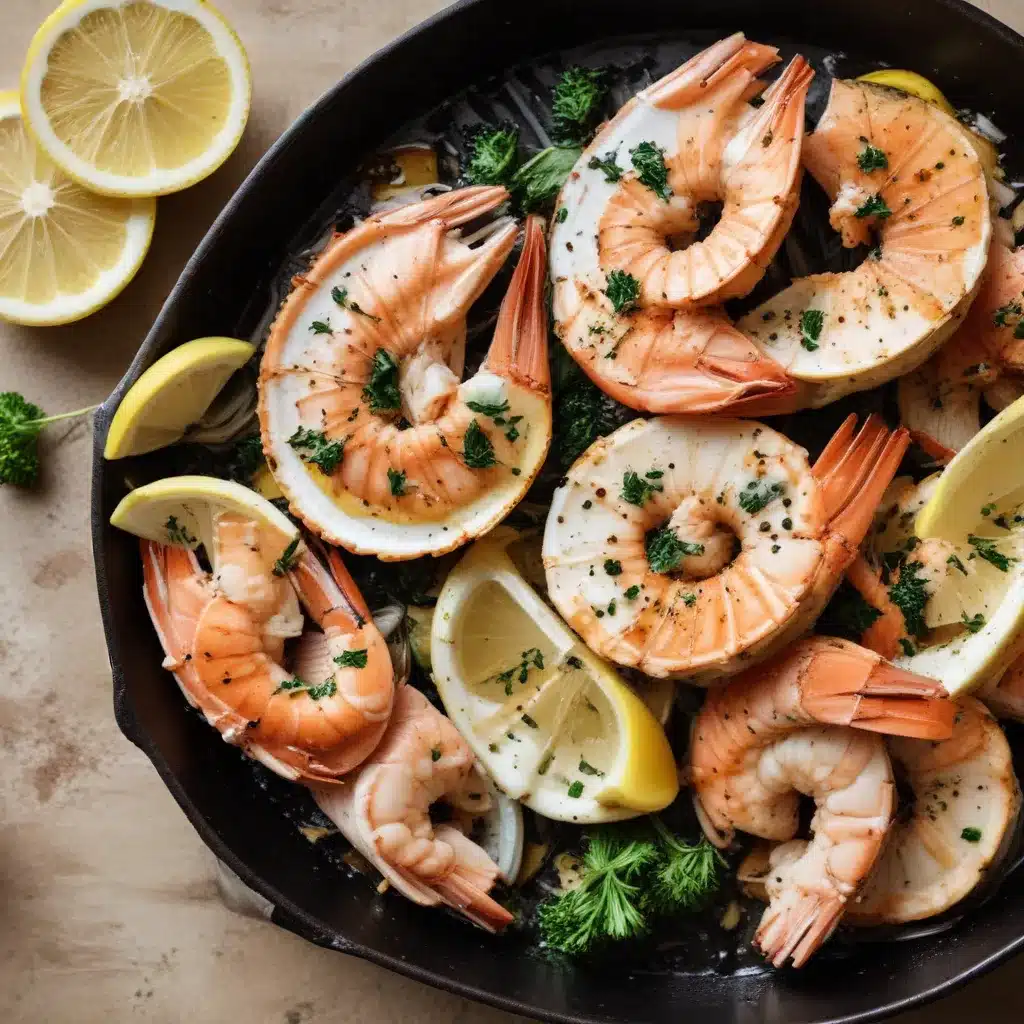
As an expert seafood dining writer for Fish Tales Cafe, I’m delighted to share my insights on cooking various types of fish and shellfish to perfection. Whether you’re grilling, baking, or sautéing, mastering seafood preparation is an art form that can elevate any meal.
Seafood Preparation Techniques
Grilling Seafood
Grilling seafood imparts a delightful smoky flavor and crisp texture. To achieve the best results, start with fresh, high-quality fillets or steaks. Brush them lightly with oil or melted butter to prevent sticking, and season generously with herbs, spices, or citrus zest. Grill over medium-high heat, turning once, until the fish flakes easily with a fork. Be careful not to overcook, as seafood can become dry and tough.
Baking Seafood
Baking is an excellent method for delicate fish like sole or flounder, as well as firm varieties like salmon or cod. Preheat your oven to 400°F (200°C). Place the seafood in a lightly greased baking dish, drizzle with olive oil or melted butter, and season as desired. Bake for 12-18 minutes, depending on thickness, until the fish is opaque and flakes easily. Experiment with en papillote (baked in parchment paper) for extra moisture and flavor.
Sautéing Seafood
Sautéing is a quick and versatile cooking technique that works well for thin fillets, shrimp, or scallops. Heat a large skillet over medium-high heat and add a small amount of oil or butter. Pat the seafood dry and season generously. Sear the fish or shellfish for 2-3 minutes per side, until it develops a nice golden-brown crust. Finish with lemon juice, white wine, or a butter-based sauce for maximum flavor.
Seafood Types
Finfish
Cod, halibut, tilapia, and tuna are just a few examples of the diverse world of finfish. These versatile proteins can be prepared using any of the above methods, and their mild flavors lend themselves well to a wide range of seasonings and sauces.
Shellfish
Shrimp, scallops, mussels, and clams are beloved shellfish that add a touch of elegance to any meal. Shellfish often benefit from quick-cooking techniques like sautéing or grilling to preserve their delicate textures and natural sweetness.
Crustaceans
Crab and lobster are luxurious crustaceans that can be grilled, baked, or sautéed. Their rich, succulent flavors pair beautifully with drawn butter, citrus, or herb-infused sauces.
Seafood Flavor Profiles
Mild Flavors
Cod, tilapia, and sole are examples of mild-flavored fish that provide a gentle canvas for bold seasonings and sauces. These varieties are often considered more accessible for those new to seafood.
Stronger Flavors
Salmon, tuna, and mackerel possess bolder, more pronounced flavors that can stand up to robust marinades and preparations. These fish are particularly well-suited for grilling or baking.
Delicate Textures
Scallops, shrimp, and crab boast delicate, tender textures that require gentle handling. Sautéing or quick-cooking methods are ideal to preserve their luxurious mouthfeel.
Nutritional Benefits of Seafood
Protein Content
Seafood is an excellent source of high-quality protein, making it a nutritious addition to any diet. A 3-ounce serving of cod or salmon can provide 20-25 grams of protein.
Omega-3 Fatty Acids
Many types of fish, especially fatty varieties like salmon, tuna, and mackerel, are rich in omega-3 fatty acids. These healthy fats offer various cardiovascular and cognitive benefits.
Vitamin and Mineral Profiles
Seafood is packed with essential vitamins (like vitamin B12 and D) and minerals (such as selenium, zinc, and iron). Incorporating diverse seafood options into your meals can help you meet your daily nutrient needs.
Seafood Cooking Equipment
Grill or Broiler
A hot grill or broiler is the perfect tool for delivering a beautiful char and smoky flavor to fish and shellfish.
Oven or Baking Dish
Baking seafood in the oven or en papillote in a parchment paper packet allows for easy, hands-off preparation.
Sauté Pan or Skillet
A well-heated, nonstick skillet is ideal for searing and sautéing delicate seafood like shrimp, scallops, and thin fish fillets.
Seafood Seasoning and Marinades
Herb and Spice Blends
Experiment with fresh herbs, crushed spices, garlic, and citrus zest to add vibrant flavors to your seafood dishes.
Citrus and Acidic Marinades
Lemon, lime, orange, or white wine marinades can help tenderize and infuse seafood with bright, refreshing notes.
Butter and Oil-Based Sauces
Lemon-butter, white wine-butter, or herb-infused olive oil sauces are delightful complements to grilled, baked, or sautéed seafood.
Seafood Presentation and Serving
Plating Techniques
Arrange your cooked seafood artfully on the plate, perhaps with a drizzle of sauce, a sprinkle of chopped herbs, or a few edible flowers for a visually stunning effect.
Garnishes and Accompaniments
Consider serving seafood with roasted vegetables, herbed rice or quinoa, or a simple green salad to create a well-rounded and balanced meal.
Portion Sizes
As a general guideline, plan for a 4-6 ounce portion of fish or shellfish per person, adjusting as needed based on your guests’ appetites.
Seafood Safety and Handling
Freshness Indicators
Look for seafood with a bright, shiny appearance, firm flesh, and a fresh, briny aroma. Avoid any items that seem discolored, mushy, or have a strong, unpleasant odor.
Temperature Control
Keep raw seafood refrigerated at 40°F (4°C) or below until ready to cook. Maintain proper food safety protocols to prevent cross-contamination.
Proper Thawing Methods
Thaw frozen seafood in the refrigerator, not at room temperature, to ensure food safety and optimal texture.
Whether you’re grilling, baking, or sautéing, mastering the art of cooking seafood can be a rewarding and delicious journey. With the right techniques, seasonings, and attention to detail, you can elevate any dish and impress your guests. For more seafood inspiration, be sure to visit Fish Tales Cafe.

